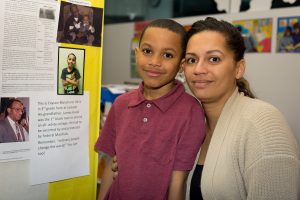
Jackson 3rd grader Cayson Blanchard and his mother, Mary Hood, pose by a display about his grandfather and her father James Hood, one of the first students to integrate the University of Alabama.
February is Black History Month across the country and there is a living, breathing bit of it right here at Jackson Elementary School that’s especially important to note in an educational context.
Third grader Cayson Blanchard is the grandson of James Hood. In 1963, Hood was one of the first black students to integrate the University of Alabama, but before he could he was famously, literally blocked as he tried to enter by then Alabama governor George Wallace. President John Kennedy intervened by federalizing the Alabama National Guard and ordering them to escort Hood and Vivian Malone inside and a door opened that many have passed through since.
Hood and Malone were personally encouraged in their bid to gain admission to their home state’s segregated university by Dr. Martin Luther King. The official basis for barring black students was inferior brains, but Hood and Malone achieved superior scores on college admissions exams.
The events in Alabama drew national attention and were at the center of the nascent civil rights movement that accomplished so much in the decade of the 1960s. The day after Hood and Malone registered for classes, Medgar Evers was murdered in Mississippi. Evers was an NAACP activist who battled to integrate the state university there.
Hood eventually forgave Wallace and attended his funeral in 1998, a year after attaining a PhD from the university he’d desegregated decades prior.
Cayson’s mother is James Hood’s daughter, Mary. They came to Des Moines in 2014, the year following Hood’s death (on MLK Day in 2013, the same day Barack Obama was inaugurated for his second term) and Cayson remembers his grandpa.
“He taught me my ABCs,” Cayson said, sitting in the library at Jackson where librarian Patty Ryan arranged a Black History Month display. His favorite candy is anything Hershey’s, but he refers to it as “Grandpa’s chocolate,” because it was also Hood’s favorite.
Ask Cayson’s mom in what ways her son most resembles her father and the first thing she mentions is that “Cayson loves to have discussions.” Which prompts Cayson to mention that “I also love books.” But he wants to grow up to be a race car driver, perhaps a reflection that he naturally goes fast. Only eight, his mother says that he prefers to handwrite in cursive, for instance.
Maybe someday he can finish writing a book that James Hood started but hadn’t completed when he died. Mary discovered it on a set of discs in her father’s belongings. It’s about George Wallace and James Hood’s belief that the nemesis who became his friend wasn’t truly a racist, but an opportunistic politician who pandered to the bigotry of his constituency in order to win votes.
The arcs of their lives and their relationship represent not only a partial timeline of black history in America, but also perhaps an example of a path to reconciliation that is a key to America’s future. After all, if George Wallace and James Hood could finally come to understand one another, what’s stopping the rest of us?
Cayson’s mom said another characteristic of her father’s that Cayson has absorbed is a preference for black shoes. Maybe the grandson will one day fill his grandfather’s shoes, just as so many have already walked in his indelible footsteps.





